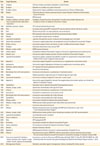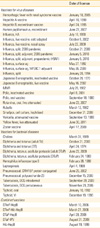1. Lee JK, Choi WS. Immunization policy in Korea. Infect Chemother. 2008. 40:14–23.

2. Korea Centers for Disease Control and Prevention. National immunization program. Mon Newsl Natl Immun Program. 2007. 5:117–118.
3. Korea Centers for Disease Control and Prevention. Epidemiology and prevention of vaccine-preventable diseases. 2011. Seoul: Korea Centers for Disease Control and Prevention.
4. Chun CH. Overview of acute communicable diseases in Korea. 1975. Seoul: Newest Medicine Co.;85–88.
5. Korean Society of Infectious Diseases. History of communicable diseases in Korea. 2009. Seoul: Kunja Publishing Co.;319–410.
6. Kim SH, Yeo SG, Jang HC, et al. Clinical responses to smallpox vaccine in vaccinia-naive and previously vaccinated populations: undiluted and diluted Lancy-Vaxina vaccine in a single-blind, randomized, prospective trial. J Infect Dis. 2005. 192:1066–1070.

7. Jang HC, Kim CJ, Kim KH, et al. A randomized, double-blind, controlled clinical trial to evaluate the efficacy and safety of CJ-50300, a newly developed cell culture-derived smallpox vaccine, in healthy volunteers. Vaccine. 2010. 28:5845–5849.

8. Lee HW, Lee PW, Johnson KM. Isolation of the etiologic agent of Korean hemorrhagic fever. J Infect Dis. 1978. 137:298–308.

9. French GR, Foulke RS, Brand OA, Eddy GA, Lee HW, Lee PW. Korean hemorrhagic fever: propagation of the etiologic agent in a cell line of human origin. Science. 1981. 211:1046–1048.

10. Lee HW, Ahn CN. Development of inactivated vaccine against hemorrhagic fever with renal syndrome. J Korean Soc Virol. 1988. 18:143–148.
11. Chu YK, Gligic A, Tomanovic S, et al. A field efficacy trial of inactivated Hantaan virus vaccine (Hantavax (TM)) against hemorrhagic fever with renal syndrome (HFRS) in the endemic areas of Yugoslavia from 1996 to 1998. J Korean Soc Virol. 1999. 29:55–64.
12. Park K, Kim CS, Moon KT. Protective effectiveness of hantavirus vaccine. Emerg Infect Dis. 2004. 10:2218–2220.

13. Sohn YM, Roh HO, Kim HS. Neutralizing antibody response to two doses of formalin inactivated mouse brain-derived Hantaan virus vaccine (HantavaxR) in healthy adults. Korean J Infect Dis. 1998. 30:325–331.
14. Chu YK, Woo YD, Lee HW. Immune response and antibody persistence against Hantaan virus of vaccinees with Hantavax (TM). Korean J Infect Dis. 1998. 30:317–324.
15. Cho HW, Howard CR. Antibody responses in humans to an inactivated hantavirus vaccine (Hantavax). Vaccine. 1999. 17:2569–2575.

16. Woo YD, Chu YK, Baek LJ, Lee HW. An immunoserological study of vaccine against haemorrhagic fever with renal syndrome. J Korean Soc Virol. 2000. 30:11–18.
17. Sohn YM, Rho HO, Park MS, Kim JS, Summers PL. Primary humoral immune responses to formalin inactivated hemorrhagic fever with renal syndrome vaccine (Hantavax): consideration of active immunization in South Korea. Yonsei Med J. 2001. 42:278–284.

18. Cho HW, Howard CR, Lee HW. Review of an inactivated vaccine against hantaviruses. Intervirology. 2002. 45:328–333.

19. Lee HW, Baek LJ, Woo YD. The persistence of immunity against hemorrhagic fever with renal syndrome among Hantaan virus vaccinees. J Korean Soc Microbiol. 1992. 27:73–77.
20. Shinozaki F, Sada E, Tamai T, Kobayashi Y. Characterization of Leptospira strains HY-1, HY-2, and HY-10 isolated in Korea by means of monoclonal antibodies and restriction endonuclease DNA analysis. Am J Trop Med Hyg. 1992. 46:342–349.

21. Kim MH, Park SC. Korean Society of Infectious Diseases. Leptospirosis. Vaccination for adult. 2012. 2nd ed. Seoul: MIP;225–235.
22. Kim YT. Current situation and elimination plan of influenza. J Korean Med Assoc. 2004. 47:1116–1128.

23. Korea Centers for Disease Cntrol and Prevention. Analysis of reported pandemic influenza (A/H1N1 2009) virus infections in Korea: from April, 2009 through August, 2010. Public Health Wkly Rep. 2010. 3:637–642.
24. Oh CE, Lee J, Kang JH, et al. Safety and immunogenicity of an inactivated split-virus influenza A/H1N1 vaccine in healthy children from 6 months to <18 years of age: a prospective, open-label, multi-center trial. Vaccine. 2010. 28:5857–5863.

25. Cheong HJ, Song JY, Heo JY, et al. Immunogenicity and safety of the influenza A/H1N1 2009 inactivated split-virus vaccine in young and older adults: MF59-adjuvanted vaccine versus nonadjuvanted vaccine. Clin Vaccine Immunol. 2011. 18:1358–1364.

26. Lee YK, Kwon Y, Kim DW, et al. 2009-2010 novel influenza A (H1N1) vaccination coverage in the Republic of Korea. Am J Infect Control. 2012. 40:481–483.

27. Oh MD. Korean Society of Infectious Diseases. Adult vaccination: Why we need it? Vaccination for adult. 2012. 2nd ed. Seoul: MIP;2–6.
28. Lim J, Eom CS, Kim S, Ke S, Cho B. Pneumococcal vaccination rate among elderly in South Korea. J Korean Geriatr Soc. 2010. 14:18–24.










 PDF
PDF ePub
ePub Citation
Citation Print
Print



 XML Download
XML Download